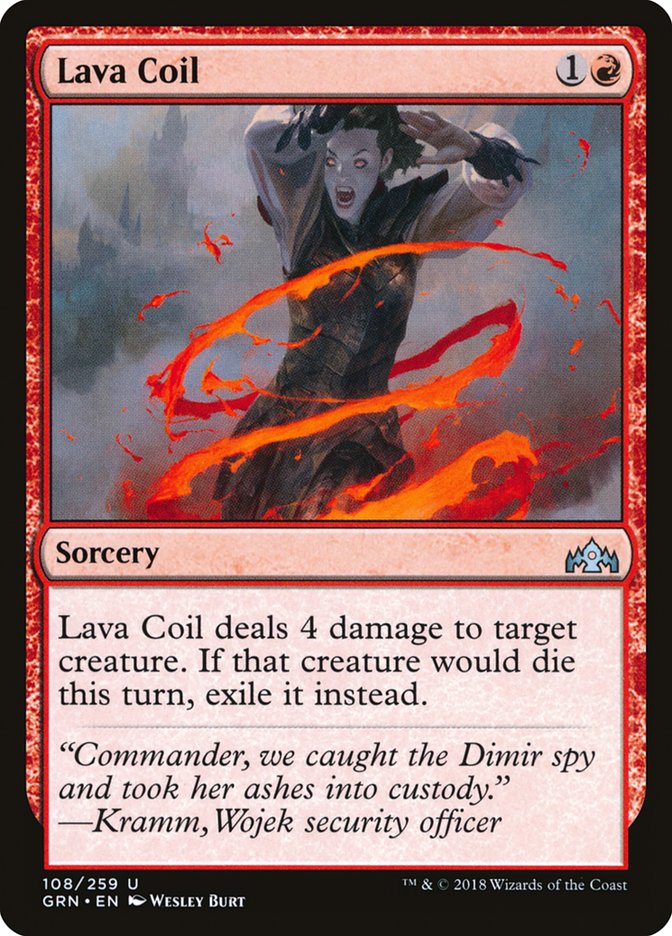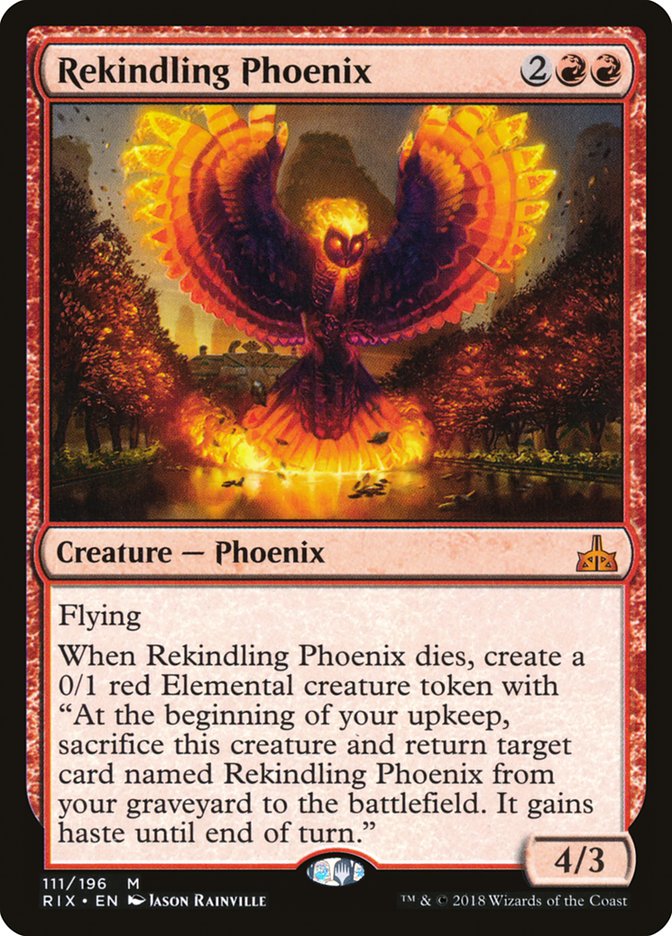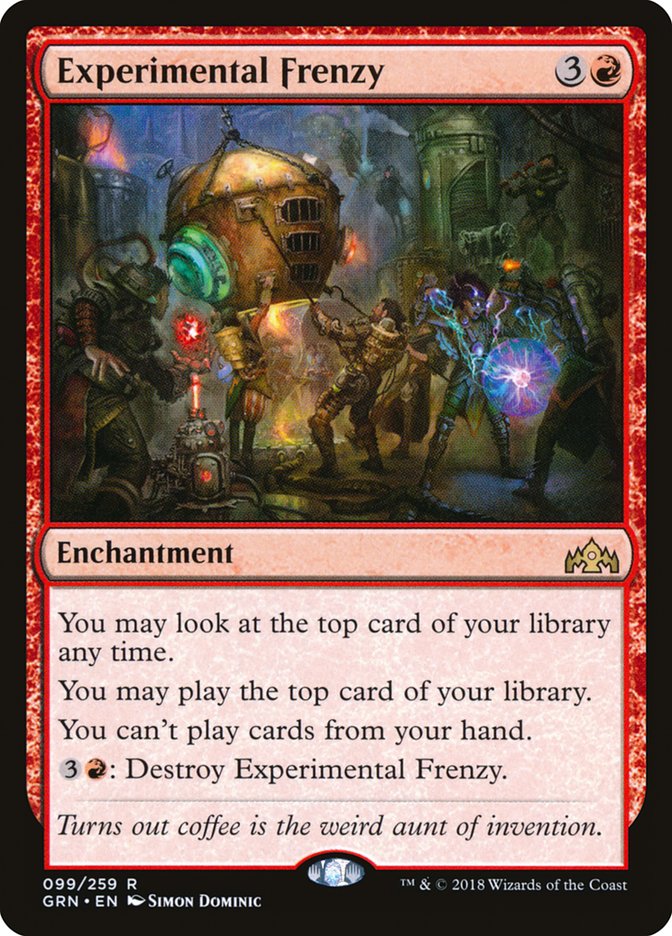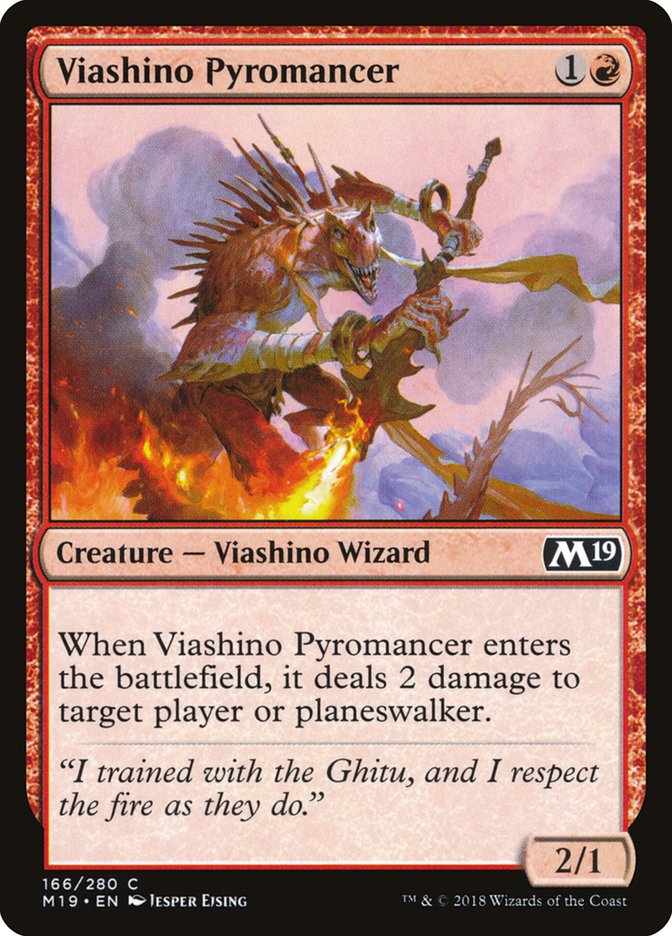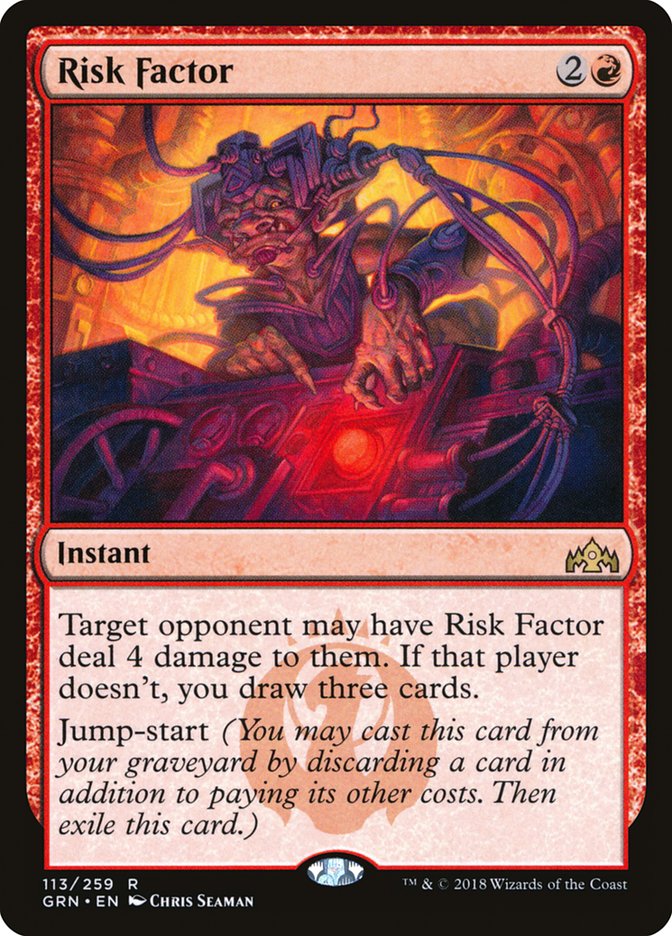I didn’t set out to play Fanatical Firebrand at Pro Tour Guilds of Ravnica, but it was one of the best decisions I’ve made
recently. Make no mistake: Mono-Red Aggro is the best deck you can be
playing in Standard, especially following the results of the PT. Maybe
you’ve played Mono-Red Aggro in some form or another, but if you didn’t
walk away from the experience thinking “This deck can beat anything,” you
were doing it wrong.
Eric Froehlich was insistent on playing Mono-Red, and although it took a
little convincing, I eventually agreed. We hammered out our sideboarding
plans in the days leading up to the PT, shared it with the rest of our
squad, and we were on our way.
This is what we played.
Creatures (20)
- 4 Fanatical Firebrand
- 4 Ghitu Lavarunner
- 4 Goblin Chainwhirler
- 4 Viashino Pyromancer
- 4 Runaway Steam-Kin
Lands (22)
- 22 Mountain
Spells (18)
Sideboard

We chose Mono-Red because it was the best check to Boros Aggro and had game
against everything else. Golgari Midrange was the biggest fear, but was
still a winnable matchup.
You might not think of Mono-Red Aggro as a deck with a lot of play to it or
something you can value from changing a few cards, but I’m here to tell you
that both of those things are false. Standard has decks that operate on
every end of the spectrum, and while your Plan A is to get them dead, your
maindeck and sideboard choices will greatly alter your results.
Mono-Red being a playable deck starts with Lava Coil. The first list I drew
up had three maindeck and EFro quickly moved it to four copies. Wildgrowth
Walker is a huge issue, both as something that puts them out of burn range,
but also as a card that will clock you very quickly. Crackling Drake is
another powerful, multi-purpose threat that you need to dispose of. Golgari
lists have also started maindecking Thrashing Brontodon, so the necessity
for Lava Coil is high.
You could sideboard them all and stick to the burn plan, but you want them
against every matchup except for pure control decks and you need them in
the first game. With Experimental Frenzy in your deck, you want each of
your cards to be proactive so you can keep casting spells from the top of
your deck, but Lava Coil has enough targets that it’s warranted.
Why zero copies of Rekindling Phoenix in the 75?
The short answer is that it’s kind of bad. The longer answer is that decks
are prepared to fight that sort of sideboard plan from you and those are
the matchups where you want Risk Factor instead of Phoenix or Experimental
Frenzy. Trying to outmuscle decks that have Carnage Tyrant isn’t a viable
strategy, so you should be looking for ways to go under them instead.
It doesn’t help that one of the most popular removal spells is Lava Coil
either.
One of the most common questions about Experimental Frenzy is whether you
should play your fifth land before you play your Frenzy on Turn 5 or not.
While the answer is somewhat contextual based on your hand and what’s
happening in the game, if you’re in doubt the answer should be a resounding
“yes.”
More games than you think will involve you destroying your Frenzy, so
having a flush hand after you do so will matter. Being able to make land
drops to unleash your spells is part of that, but I wouldn’t worry too much
about trying to sandbag a land.
Some have made the observation that the player with Experimental Frenzy
almost always wins, and although that’s close to true, you still have to
maximize those small edges as best you can. The longer you have Frenzy on
the battlefield, the more of a favorite you become. Each land drop is of
the utmost importance because of how well each extra mana scales with
Frenzy. You’ll often have more lands left in your deck than one-mana cards,
but ensuring you have more mana on later turns is exponential.
The more mana you have on the battlefield, the less important it is to play
your land before your Experimental Frenzy. If you have six lands, your odds
of finding a land before your turn ends are relatively high. If you don’t
find one, it sucks, but you were a favorite.
The tiny Wizards package is responsible for some of the best draws Mono-Red
is capable of getting, but it’s also responsible for your worst draws.
Drawing multiple Wizard’s Lightnings against a deck that is killing your
creatures is a surefire way to lose. By trimming on the amount of
high-variance cards, you end up with a deck that’s more stable, which will
benefit you over the course of a long tournament.
Wizard’s Lightning is potentially powerful, but building your own Lightning
Bolt shouldn’t be the only thing the deck is about. After sideboard, you’ll
often shave Wizards which means you’ll want to cut Wizard’s Lightning
anyway.
Risk Factor was originally showing up in the Mono-Red Aggro decks until it
was eventually supplanted by Experimental Frenzy. As the format evolved,
the opposition began to respect Experimental Frenzy with cards like Vivien
Reid.
While Experimental Frenzy is great against any grindy matchup like control
or a mirror match, Risk Factor is much stronger against matchups that
either have answers to Frenzy or want to race you. It’s also incredible in
those slower control matchups that will have a pile of removal and answers
to Experimental Frenzy, like Jeskai Control. Good luck getting your
opponent to zero when they Ixalan’s Binding your Frenzy and have Revitalize
in their deck.
Black control decks are about the same. While they can’t remove Frenzy,
they can kill all your stuff, gain life with Moment of Craving and Vraska’s
Contempt, and clock you with Doom Whisperer. In those matchups, Risk Factor
truly shines, but you still want access to as many swingy cards as
possible, which is why you’ll have both Frenzy and Risk Factor in your deck
after sideboard.
Against decks like Golgari Midrange and Izzet Drakes, you don’t have
infinite time to be working with Frenzy, as your opponent will be trying to
kill you quickly. Your cards will almost never line up in such a where
you’re able to completely stifle their aggression, so your plan shouldn’t
be to play a long game. In those matchups, I want Risk Factor instead of
Frenzy.
Sideboarding
In most matchups, you’re going to have some dead cards, or at least some
cards you’d prefer to not have in your deck against a certain matchup.
Since this deck has many different ways it can go bigger, the most
important thing is visualizing how the games are going to play out
post-board and constructing your post-board configuration to fit that.
Are you trying to burn your opponent out because they have too much
removal? Are you trying to chip damage them, control the game state for as
long as you can, then finish them off?
VS Golgari Midrange
Here, Frenzy is less good because they have answers for it and they will be
pressuring you, so either way you won’t have many turns to utilize it to
its full potential. That’s a huge liability at four mana. Rather than
trying to play a longer game against them, use Risk Factor to its full
potential!
Out:
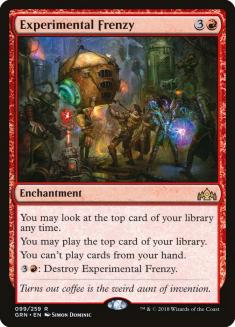




In:
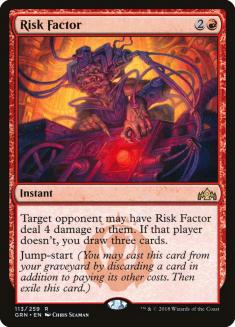

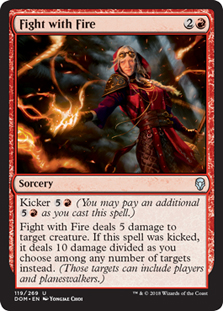


Keep the pressure on, clear the way, and burn them out. Treasure Map can
help against particularly hateful builds with lots of lifegain if you need
the extra staying power but isn’t worth it against most builds.
Overall, Golgari isn’t the best matchup but is entirely beatable.
VS Izzet Drakes
Out:




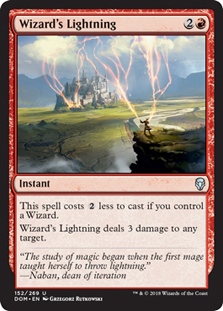





In:




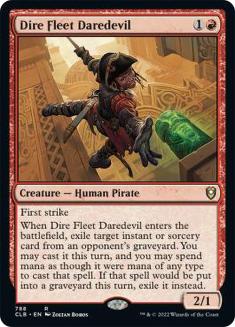


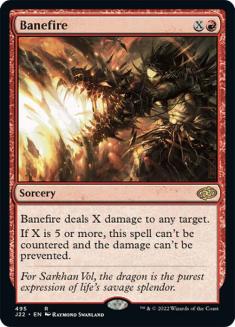


Going into the Pro Tour, Goblin Electromancer wasn’t popular, but it might
be making a resurgence given that the best performing versions played it.
Keeping in Shock over Lightning Strike isn’t a huge deal, but Lightning
Strike could tag team with Fanatical Firebrand or Goblin Chainwhirler to
kill a Drake.
If Murmuring Mystic becomes the new standard, another Fight with Fire is
probably a good addition.
VS Jeskai Control
Out:




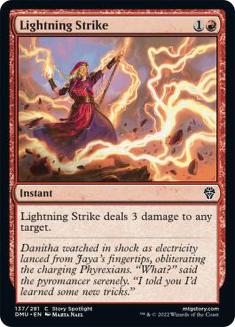




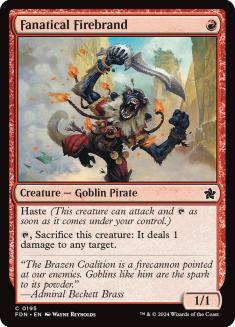



In:









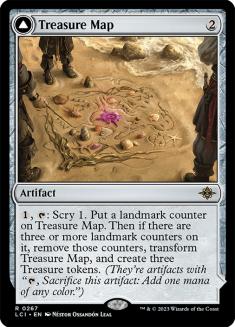



Not that you really need it, but most of your sideboard comes in here. This
gives your cards a much higher impact on average and allows you to go
toe-to-toe with their card advantage and lifegain.
If your opponent has Ixalan’s Binding, consider siding out one copy of
Experimental Frenzy. If they have Crackling Drakes, you’ll want all the
Lava Coils, but feel free to swap them out if you don’t see any.
Dire Fleet Daredevil can do some sweet things, such as exiling a
counterspell before combat, so you don’t lose to Settle the Wreckage, keep
a Search for Azcanta from transforming, or remove one of their Crackling
Drakes with their own Lava Coil.
Unless Jeskai can stick a threat like Lyra Dawnbringer, they will have an
incredibly difficult time beating you.
VS Mono-Red Aggro
Out:






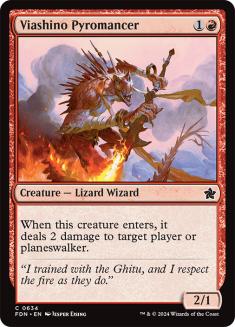


In:









The mirror can be silly.
Sometimes Experimental Frenzy is all that matters, and sometimes your
opponent can get under you. Being on the Risk Factor plan is reasonable,
especially if you’re on the play, but between all the removal spells flying
on both sides, the games will probably go long.
If you really want to hammer mirror matches, I recommend sideboarding some
copies of Demanding Dragon.
VS Boros Aggro
Out:







In:
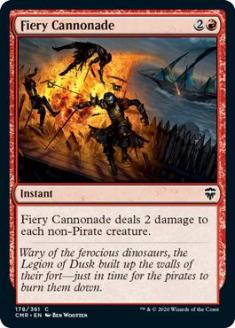






If there’s a reason to play Mono-Red, it’s because of how badly it will
dismantle most Boros decks. Ajani’s Pridemate and Snubhorn Sentry are cards
that could potentially give you an issue because of how much you rely on
Goblin Chainwhirler and Fiery Cannonade to do the heavy lifting, so an
alternate sideboard plan might be necessary. If your opponents want to
sideboard in Aurelia, Exemplar of Justice against you, Fight with Fire is
necessary.
VS Grixis Control
Out:









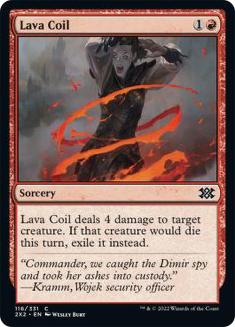

In:











Grixis doesn’t have a definitive “best” version, although I imagine many
people will be copying Shota’s version.
Creatures (6)
Lands (26)
Spells (28)

It’s a strange matchup because in the early game, all you want is something
that can pressure your opponent constantly. Lategame, all you ever want to
draw are burn spells to close the game while your opponent sits on a
handful of spot removal. Some concessions could probably be made there,
like keeping in a couple Lightning Strikes and siding out some Goblin
Chainwhirlers.
Other Options
If Risk Factor is the staying power card of choice against the majority of
the field, maybe we’re supposed to be looking at other options entirely.
Should Boros Aggro take over the format, Experimental Frenzy is likely the
better choice.
As always, Magic Online is likely one step ahead.
Creatures (20)
- 4 Fanatical Firebrand
- 4 Ghitu Lavarunner
- 4 Goblin Chainwhirler
- 4 Viashino Pyromancer
- 4 Runaway Steam-Kin
Lands (21)
- 21 Mountain
Spells (19)
Sideboard

This PTQ had three copies of Mono-Red Aggro in the elimination rounds,
although it was the version with maindeck Risk Factors and zero copies of
Experimental Frenzy that took it down.
Although this deck was clearly successful, I can’t recommend playing
Mono-Red without some amount of Lava Coils maindeck. Maybe you can pick off
Wildgrowth Walkers with some well-timed Wizard’s Lightnings, but it’s not
realistic. Either way, Crackling Drake will be a huge issue, and Izzet
Drakes was basically the best performing deck at the Pro Tour.
Here’s a fun take on Mono-Red that EFro and I tried before the PT.
We were basically looking for one more good discard outlet to make Arclight
Phoenix consistent enough, but casting it was just fine. The real issue was
that we didn’t see a big enough reason to play this version over the Frenzy
version because Arclight Phoenix mostly helped your good matchups. Your
best draws can help against Golgari, but for the most part, you’re just
spinning your wheels a bunch for no real gain.
If I were playing Grand Prix Milwaukee this weekend, I’d be sleeving up
either Mono-Red Aggro or Izzet Drakes. Mono-Red continues to be
under-appreciated and misunderstood, but the Boros decks might adapt,
Golgari might improve, and Izzet could also be out in full force. Any
number of those things could make the Mono-Red resurgence die before it
even got off the ground.
I doubt that’ll be the case, but stranger things have happened.


